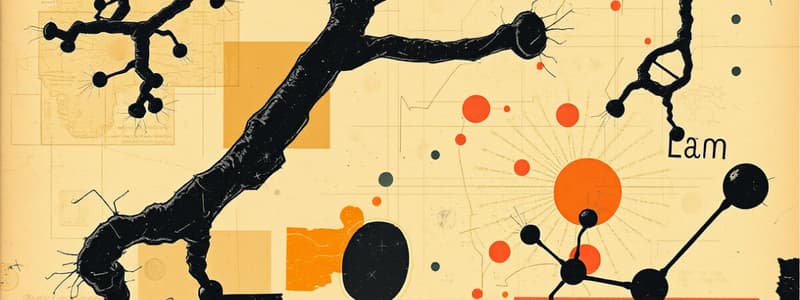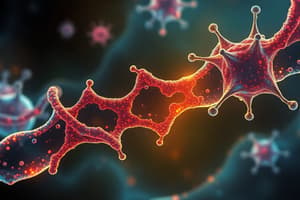Podcast
Questions and Answers
What is the role of the Fc fragment of an antibody?
What is the role of the Fc fragment of an antibody?
- It determines the antibody isotype.
- It binds directly to the antigen.
- It contains the hypervariable regions.
- It assists in opsonization. (correct)
Which of the following statements about the variable region of antibodies is true?
Which of the following statements about the variable region of antibodies is true?
- It is composed solely of constant regions.
- It is the same across all antibody types.
- It is exclusively found in the light chain.
- It exhibits significant diversity due to gene recombination. (correct)
Which isotypes of antibodies are defined by having different heavy chain constant regions?
Which isotypes of antibodies are defined by having different heavy chain constant regions?
- IgE and IgM
- IgM and IgD
- IgG and IgA
- IgG, IgA, IgM, IgE, and IgD (correct)
Which enzyme cleaves antibodies into two Fab fragments and one Fc fragment?
Which enzyme cleaves antibodies into two Fab fragments and one Fc fragment?
Which part of the antibody structure is referred to as the paratope?
Which part of the antibody structure is referred to as the paratope?
What are the two isotypes of light chains in antibodies?
What are the two isotypes of light chains in antibodies?
Which statement correctly describes the C regions of antibodies?
Which statement correctly describes the C regions of antibodies?
What is the approximate molecular weight of one heavy chain of a typical antibody?
What is the approximate molecular weight of one heavy chain of a typical antibody?
What is the role of the RAG-1 and RAG-2 enzymes in immunoglobulin gene segment recombination?
What is the role of the RAG-1 and RAG-2 enzymes in immunoglobulin gene segment recombination?
What describes the 'germline configuration' of immunoglobulin genes?
What describes the 'germline configuration' of immunoglobulin genes?
Which sequence is NOT part of the variables coded for by immunoglobulin genes?
Which sequence is NOT part of the variables coded for by immunoglobulin genes?
How do Recombination Signal Sequences (RSS) facilitate the process of immunoglobulin gene rearrangement?
How do Recombination Signal Sequences (RSS) facilitate the process of immunoglobulin gene rearrangement?
What is the significance of the 12/23 rule in immunoglobulin gene recombination?
What is the significance of the 12/23 rule in immunoglobulin gene recombination?
Which domains increase diversity in immunoglobulin variable regions?
Which domains increase diversity in immunoglobulin variable regions?
Which of the following statements about immunoglobulin constant and variable regions is true?
Which of the following statements about immunoglobulin constant and variable regions is true?
What types of cells contain RAG-1 and RAG-2 enzymes?
What types of cells contain RAG-1 and RAG-2 enzymes?
What is a common characteristic of most antigens?
What is a common characteristic of most antigens?
Which type of bond is NOT typically involved in the interaction between organic macromolecules?
Which type of bond is NOT typically involved in the interaction between organic macromolecules?
In the context of DNA, what do exons represent?
In the context of DNA, what do exons represent?
What role do introns play in eukaryotic cells?
What role do introns play in eukaryotic cells?
Which statement best describes the 'Lock and Key' model in molecular binding?
Which statement best describes the 'Lock and Key' model in molecular binding?
What is the significance of glycosylation in post-translational modification?
What is the significance of glycosylation in post-translational modification?
What is a characteristic of polypeptides that qualifies them as proteins?
What is a characteristic of polypeptides that qualifies them as proteins?
Which of the following best describes the information carried by organic macromolecules?
Which of the following best describes the information carried by organic macromolecules?
What is the role of differential mRNA splicing in B-cell development?
What is the role of differential mRNA splicing in B-cell development?
Which statement is true regarding isotype switching in B-cells?
Which statement is true regarding isotype switching in B-cells?
How does allelic exclusion impact B-cell development?
How does allelic exclusion impact B-cell development?
What is the final form of IgM upon secretion from B-cells?
What is the final form of IgM upon secretion from B-cells?
What is the purpose of the hydrophobic MC region in immunoglobulins?
What is the purpose of the hydrophobic MC region in immunoglobulins?
Which immunoglobulin is commonly responsible for immediate hypersensitivity reactions?
Which immunoglobulin is commonly responsible for immediate hypersensitivity reactions?
What is the outcome of affinity maturation in antibodies?
What is the outcome of affinity maturation in antibodies?
Flashcards are hidden until you start studying
Study Notes
Antibody Structure
- Antibodies are Y-shaped glycoproteins made of 4 polypeptide chains: 2 heavy (50 kDa each) and 2 light (25 kDa each) chains.
- Chains are connected by disulfide bonds, consisting of a variable region (N-terminus) and constant regions.
Antibody Specificity and B-cell Activation
- Each antibody (Aby) has a unique specificity; the human antibody repertoire contains approximately 10^16 variations.
- B-cells express a single immunoglobulin (Ig) type on their surface and differentiate into plasma cells upon antigen (Ag) binding.
Antibody Functional Regions
- Protease digestion reveals antibody functional regions:
- Papain cleaves antibodies into 2 Fab (Fragment antigen binding) and 1 Fc (Fragment crystallizable).
- Pepsin digests the Fc fragment, yielding F(ab')2.
- The Fc region is crucial for opsonization.
Antibody Isotypes
- Immunoglobulin isotypes (classes) differ in the constant regions of heavy and light chains; five major isotypes exist: IgG, IgA, IgM, IgE, IgD (GAMED).
- Heavy chains are denoted by Greek letters: γ, α, μ, ε, δ; light chains have two types: Kappa (κ) and Lambda (λ).
Variable and Constant Domains
- Immunoglobulin domains range from 100-110 amino acids.
- The variable region (V-region) includes VH (heavy chain) and VL (light chain) domains, while the constant regions have limited sequence diversity.
Antigen-binding Site
- Known as the paratope, consists of framework regions (FR) and hypervariable (HV) loops called complementarity determining regions (CDRs).
- CDRs are responsible for the specificity of antigen binding.
Antigenic Determinants (Epitopes)
- Antibodies bind antigens at specific sites known as epitopes, often composed of carbohydrates, proteins, or both.
- Most antigens present multiple epitopes, making them multivalent.
Binding Mechanism
- Antibody-antigen interactions exhibit molecular complementarity through non-covalent binding (ionic, hydrogen bonds, hydrophobic effects, van der Waals attractions).
- The "Lock and Key" model indicates specific interactions based on shape and charge compatibility.
Gene Structure and Protein Coding
- Antibodies are proteins coded by segments of DNA (genes); base pairs include A (Adenine), T (Thymine), C (Cytosine), G (Guanine).
- Eukaryotic DNA contains coding (exons) and non-coding (introns) segments.
Transcription and Translation
- Primary RNA transcripts from antibodies include introns, while the processed mRNA (messenger RNA) excludes them, coding for polypeptides.
Post-translational Modifications
- Polypeptide glycosylation involves sugar attachment in the Endoplasmic Reticulum and Golgi, specifically N-glycosylation and O-glycosylation.
- Glycosylation is critical for protein folding and localization.
Immunoglobulin Diversity
- Antibody diversity is generated prior to antigen encounter via gene segmentation and recombination.
- Ig genes are fragmented in all cells except B-cells, giving rise to a unique germline configuration.
Gene Segment Recombination
- RAG-1 and RAG-2 enzymes mediate gene segment recombination in B and T-cells.
- Ig constant regions are prepared for transcription, while variable regions require RAG-mediated rearrangements.
Germline Ig Genes and Diversity
- Ig genes undergo rearrangement to produce multiple combinations of V, D, and J segments, significantly enhancing diversity.
Affinity Maturation and Isotype Switching
- Somatic hypermutation in B-cells improves antibody specificity over time.
- Isotype switching allows B-cells to produce different antibody isotypes (IgM, IgG, IgA, IgE) through DNA recombination, altering the immune response without changing the V-region specificity.
Isotype Switching Mechanism
- IgM and IgD are initially expressed on B-cells via differential mRNA splicing.
- Subsequent switch to IgG, IgA, or IgE allows diversification of immune function based on the need.
Summary of Antibody Attributes
- Each antibody class features distinct functions facilitated by different constant regions, while the V-region specificity remains consistent across isotypes.
Studying That Suits You
Use AI to generate personalized quizzes and flashcards to suit your learning preferences.



